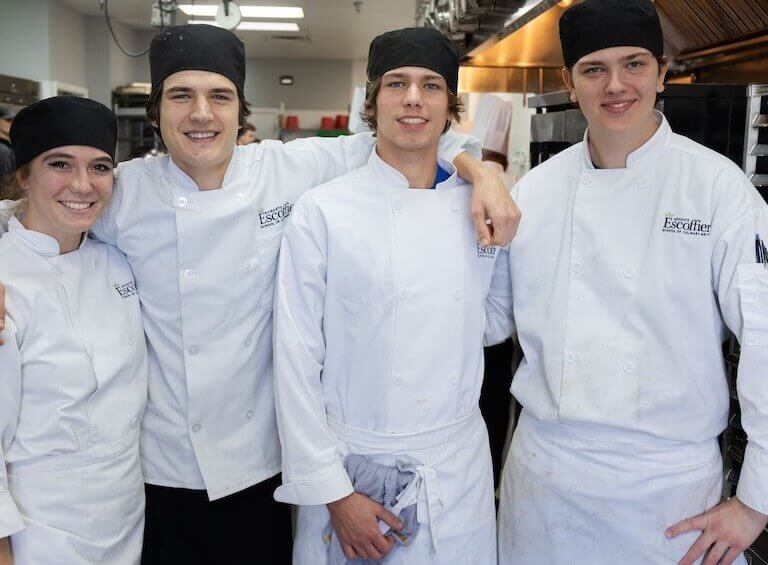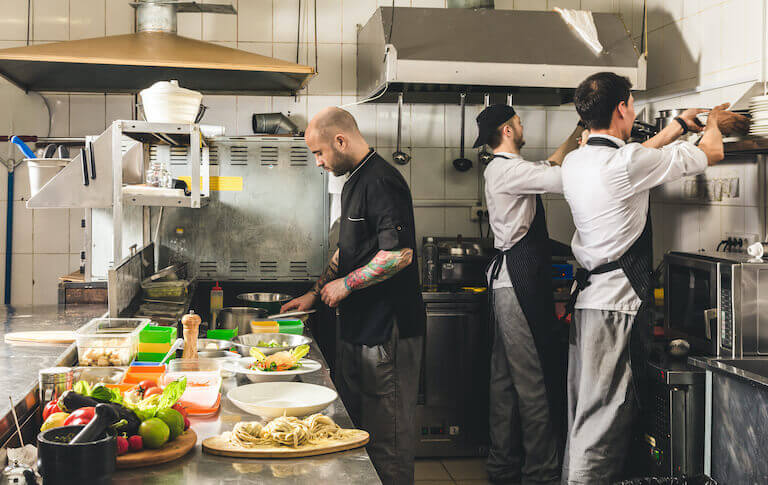For many aspiring students, the step between deciding to attend culinary school and figuring out how to pay for culinary school can feel more like a giant leap. Committing to the timeline and financial investment of any education program can be a stressful proposition!
But it gets easier when you know where to start. Financial uncertainty should not be a barrier to the education you need to pursue your goals.
Follow this step-by-step plan to create a blueprint that could put culinary school within reach.*
1. Reverse-Engineer Your Funding Goal
The best way to approach a problem is to start with the end goal and work backward. So let’s start here: how much money could you need for culinary school?
The Cost of Culinary School
Start with the cost of the program itself. Tuition and fees at different schools can vary widely. Plus, associate degree programs may be more expensive than diploma programs.
So start your plan with the cost of your ideal program. And make sure to verify whether that number is per semester, per year, or a total cost for the program.
At Auguste Escoffier School of Culinary Arts, the listed tuition costs are the total tuition and fees for the program.

Escoffier students in Boulder
Account for Living Expenses
Culinary students don’t attend school in a vacuum. They still need a roof over their heads, food in their tummies, and basic utilities like electricity and internet. These living expenses should also be part of your culinary school financial plan.
Some students may be able to continue to live at home with their families, which can help minimize their costs. Adult students may have a spouse who can support them while they complete their programs. But others may need to pay rent and cover the rest of their living expenses during school. This could require having a part-time job, a full time-job, or other financial assistance.
Also, consider relocation costs. If you plan to attend culinary school at one of Escoffier’s campuses, you will have to get to Austin, Texas or Boulder, Colorado. Of course, students who attend culinary school online can strike this line item from their calculation! Online students can complete their programs from wherever they live, as long as they have an internet connection.

Polenta, Ragu alla Bolognese, and fresh focaccia made by online culinary arts student Michelle V.
Create a budget to get an idea of how much you may need to contribute to rent, groceries, transportation, utilities, entertainment, and anything else during culinary school. Add up all of your monthly expenses for the number of months you’ll be in school.
Add that number to your total tuition costs, and you’ll have an estimate of how much money you may need to get through your program!
2. Look at Your Cash Assets to Assess How Much Funding You May Need
Once you know how much you may need, let’s figure out how much you’ve got!
Do you have any savings? Have you or a parent been funding a 529 plan? Did you receive any financial gifts from a recent high school graduation?
Will your parents or another family member be contributing to your culinary school expenses? Even a thousand dollars from a family member can help to reduce your costs!
It’s ok if you’re starting from scratch. But any cash that you can contribute to your school expenses may minimize the amount you have to borrow or earn for school!

Add up any assets, including savings, financial gifts, and education investments like a 529 plan to get started.
3. Try to Reduce Your Financial Obligation Through Scholarships, Grants, and/or Military Benefits
While loans are certainly an option (and we’ll discuss those shortly), the best kind of funding is the kind you don’t have to pay back! This could mean scholarships, grants, or military benefits for those who apply and qualify.
Scholarships and Grants
Scholarships and grants are financial awards that don’t have to be repaid. Some students may be able to pay for culinary school entirely with scholarships and grants. Much more often, students pay for school partially through scholarships and partially through other funding sources, like loans.**
The federal government also awards some grants based on financial need. This could include Federal Pell Grants or Federal Supplemental Educational Opportunity Grants. The application for these grants is the same as the application for federal student loans, which we’ll discuss shortly.
Industry groups also offer scholarships. The National Restaurant Association and state restaurant associations are both significant sources of scholarship funding for culinary school students. Other scholarships are offered based on personal circumstances, like where you live, the type of career you plan to pursue, or demographic factors.
Apply early and apply often! The more scholarship funding you collect, the closer you can get to your funding goal! And don’t only apply to the large $20,000+ scholarships. A few smaller scholarship awards can go a long way toward helping with your overall financial picture. Plus, there may be less competition for those more niche awards.
Scholarships vs. Grants: What’s the Difference?
Both scholarships and grants can be used for culinary school, and do not have to be repaid.
Scholarships are usually awarded based on merit and performance. Grants are usually awarded based on financial need, like Federal Pell Grants.
But this terminology is only general. Some institutions award need-based scholarships, while others may offer merit-based grants. Make sure to check the eligibility requirements carefully before applying!
Military Benefits
For eligible students, military and veteran’s benefits can potentially help veterans, active duty, and their families with the cost of tuition/fees for school.
Military or veteran students may be eligible for funding through Veterans Administration programs, like the Post-9/11 GI Bill®. Active Duty members could be eligible to utilize Tuition Assistance through their branch of Military Service and can get further information by visiting their Education Office.
Escoffier also offers a $1,000 Military Grant for qualifying military personnel and veterans, as well as a $500 Veterans Spouse/Dependent Grant to qualifying family members.
As a 2023-2024 Military Friendly® School, Escoffier works closely with military, veteran, and military family students to provide both financial benefits and student support.***

Military and veteran students may be eligible for grants and tuition assistance to pay for culinary school.
4. Consider Holding a Job While Studying
If you can secure any funding through scholarships, grants, and/or military benefits (if applicable), you’ll see that amount due begin to shrink.
But for many students, savings, scholarships, and grants are not enough to cover the entire cost of school and living expenses.
So how else can you meet your funding needs?
Some students choose to get a part-time (or even a full-time) job while they are in culinary school. To make it easier to manage school and work, consider attending culinary school online!
Escoffier’s online programs let students attend class from their kitchens, eliminating the need to commute to and from an on-campus school. Online students get similar foundational education as on-campus students, but they are able to attend class and complete their cooking assignments on their own schedules. This can make it much easier to work a part-time job while getting your education.

Working a part-time job can help cover program and living costs while you’re in school.
Think critically about how many hours you can work while still completing your coursework. Working part-time may not be sufficient to cover all of your living expenses. So you may need to account for some extra student loans to help cover your costs while you’re in school.
Which leads us to…
5. Seek Out Student Loans to Fill the Gap
The majority of Escoffier students take advantage of some kind of financial aid to cover their education costs.**
This may include Federal Direct Loans or Parent Loans for Undergraduate Students (PLUS Loans). Direct loans may be subsidized, which means that interest does not begin to accrue until they’ve been out of school for six months. Or they may be unsubsidized, which means the borrower will begin to accrue interest right away. Subsidized loans are awarded based on financial need. PLUS Loans are specifically for the parents of students, or for eligible graduate-level students.
The application for all of this aid (as well as federal grants) is the same—the Free Application for Federal Student Aid (FAFSA). This form asks for financial details from your past tax returns and information on financial assets to determine your eligibility.
Within a few days of completing this form, students may get a Financial Aid Award offer from the schools they identified on the form, letting them know how much aid they are eligible for. Completing this form is free, and naming a school does not obligate you to apply there. So this is a great way to get a clearer picture of what you can expect in grants or loans before making your final decisions!
“The Financial Aid Department [at Escoffier] was great at communicating with me. Jordan and the team at Escoffier were always emailing me back and letting me know where I was and how things were going.”*
Brent Unruh, Escoffier Boulder Campus Graduate & Executive Chef, Target Hospitality
6. Compare What You Need to What You Have
At this point, you have a total amount needed—the combined cost of your program and your living expenses during school. And you should have a total amount of funding that you can access—the combined total of any cash you have on hand, scholarships and grants and/or military benefits, expected work income, and student loans.
How do the two columns compare? And where can you decrease the costs side, or increase the funding side?
Perhaps you budgeted for an apartment with a friend. If you add a third roommate to the picture, how does that change things? Or perhaps you can add a side hustle to your plan to earn a little extra income. How could this alleviate some of the financial burden
Another option exists—some students choose to pursue their culinary arts diploma first, and later return to school to complete their associate degree. This could be a way to break up the costs of your education into two more manageable segments.

Compare how much funding you need to how much you have, and look for ways to fill the gap.
7. Continue Applying for Scholarships!
Don’t assume that the only opportunity to apply for scholarships is during the application process. You can continue to apply for scholarships throughout your culinary school journey!
Keep looking for scholarship funding throughout your program. Even $1,000 in unexpected scholarship money can reduce your reliance on loans and make your repayments easier.*
Still Need Some Help?
Making a financial plan for culinary school is an important step in creating a successful, low-stress education experience. By researching funding options like loans and scholarships, expense reduction, and savings, you can feel confident in your ability to pay for school and reach your career goals in the culinary industry.*
If you still need a little help as you make your financial plan, Escoffier’s Financial Aid representatives are available. Get the answers to questions about tuition and fees, payment schedules, student loans, and more.
To learn more about paying for culinary school, try these articles next:
- Can You Deduct College Tuition From Taxes?
- How Long Does It Take to Pay Back Student Loan Debt…And Is It Worth It?
- Is Culinary School Expensive?
*Information may not reflect every student’s experience. Results and outcomes may be based on several factors, such as geographical region or previous experience.
**76% of Austin students and 54% of Boulder students who entered postsecondary education for the first time received some financial assistance in 2021-22 for those who applied and qualified. (College Navigator, National Center for Education Statistics)
***The Department of Veterans Affairs and Department of Defense are the determining bodies of benefit eligibility. Please click here to obtain additional information on eligible programs. GI Bill® is a registered trademark of the U.S. Department of Veterans Affairs (VA). More information about education benefits offered by VA is available at the official U.S. government website at https://www.benefits.va.gov/gibill.

 “The Financial Aid Department [at Escoffier] was great at communicating with me. Jordan and the team at Escoffier were always emailing me back and letting me know where I was and how things were going.”*
“The Financial Aid Department [at Escoffier] was great at communicating with me. Jordan and the team at Escoffier were always emailing me back and letting me know where I was and how things were going.”*

